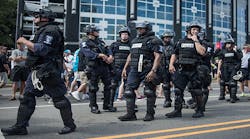Law enforcement officers who wear body armor are twice as likely to survive a shooting than those who do not, according to a new study recently published in the Journal of Occupational and Environmental Hygiene (JOEH).
Researchers found that law enforcement officers who wear body armor were 77 percent less likely to die from their injuries when shot in the torso than those who did not wear body armor. However, study authors WeiWei Liu and Bruce Taylor noted that 12 percent of officers in the United States opt to not wear body armor, despite the fact that many law enforcement agencies have a mandatory policy to do so.
Using data from the Law Enforcement Officers Killed and Assaulted (LEOKA) database, the authors examined the association between officers' individual characteristics and the likelihood of wearing body armor and the conditional association between wearing body armor and the likelihood of dying from a shooting to the torso.
“Police agencies need to target older, overweight officers, and those assigned to detective and undercover assignments when enforcing armor related policies... Agencies in the [southern United States] need to pay special attention to mandatory wearing policies,” said Liu and Taylor.
“The investigation of factors that influence police officers’ chance of surviving a gun shooting will have important implications for policies related to sending backup officers to police shootings, emergency response and other critical areas.”
In general, officers who are older or overweight, or who work in a region with more gun attacks against police such as the southern United States, are least likely to survive gunshot wounds. Those officers also are the least likely to wear body armor, the researchers point out.
The study is intended to help law enforcement agencies address weaknesses in current policies and encourage officers to wear body armor. Law enforcement agencies can use these findings to develop new programs and awareness campaigns to increase the use of body armor among officers. Agencies can also pay closer attention to officers in higher-risk groups when performing inspections for compliance with policies on wearing body armor.
